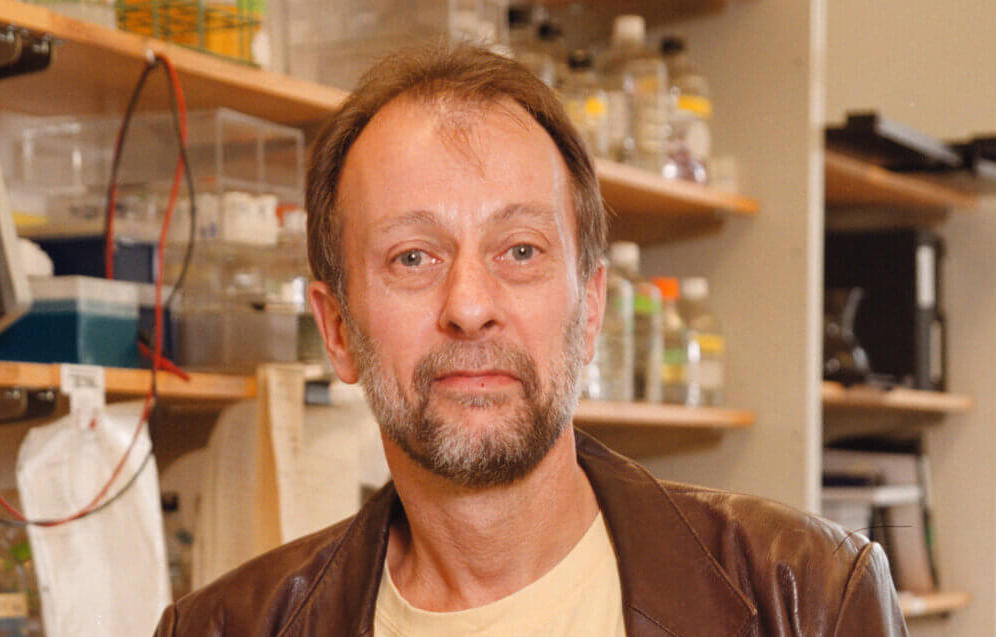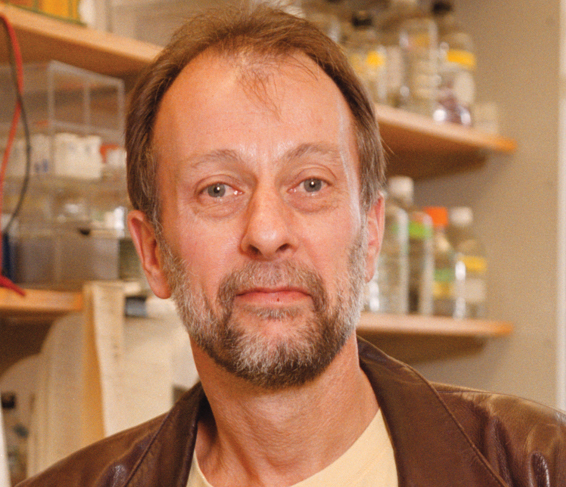Dana-Farber researcher Charles Stiles, PhD, remembers the call. It was 2008 and a colleague phoned from a conference to deliver the news. Two separate research teams had discovered a genetic driver for the most common of childhood brain tumors called pediatric low-grade glioma. The problem of finding a genetic target to improve treatment for this disease – the focus of Stiles’ research – seemed to be solved.
“We were scooped,” says Stiles. “But guess what? The problem wasn’t solved.”
Over the coming decade, a collaborative team of experts at Dana-Farber, with support from generous families, patient advocates, and the National Cancer Institute, uncovered a much more complex story. Their scientific detective work helped transform a drug that had been shelved previously by several pharmaceutical companies into a medicine, tovorafenib, that has now been approved for young patients with relapsed or progressive pediatric low-grade glioma.

“We all worked together to turn the discoveries we made in our labs into something that would benefit not just Dana-Farber patients but children all over the world,” says Daphne Haas-Kogan, MD, chair of the Department of Radiation Oncology at Dana-Farber. “Being a part of these practice-changing discoveries is just an honor beyond words.”
About 3000 children are diagnosed with pediatric low-grade gliomas each year in the U.S. This is a small number compared to adult brain cancers, but it is the most common pediatric brain tumor. Most children survive treatment but many live with neurological, hormonal, visual, or other problems the rest of their lives. New medicines are urgently needed to help these children survive with fewer lifelong side effects.
Each year, several cancer drugs are approved for adults, but vanishingly few for children, making this decades-long quest even more notable.
“This is an example of what Dana-Farber is capable of. It’s a really nice example of just how much preclinical work goes into a discovery like this one,” says Karen Wright, MD, a clinician-scientist in the Brain Tumor Center at Dana-Farber/Boston Children’s Cancer and Blood Disorders Center. “An approval for a pediatric tumor doesn’t happen very often. I think this Dana-Farber team can be very proud.”
Deep history
As a postdoctoral trainee, Stiles studied growth factors, which are proteins responsible for encouraging cells to grow. When he came to Dana-Farber in 1976, he began to focus on their potential role in brain cancer. At that time, cancer and its causes weren’t well understood. Treatments were difficult or, in many cases, nonexistent.
Years later, he and others discovered that many cancers are driven by mutations in genes for growth factors, called oncogenes. These mutations turn on uncontrolled cell growth.
“Before we knew that, we were like the proverbial blind men feeling different parts of an elephant,” says Stiles. “Over the years, we suddenly saw the whole elephant.”
By 2001, oncogenes had become the targets of a new type of medicine designed to shut down cancer growth at its source. These drugs, called targeted medicines, often had fewer side effects than traditional chemotherapy drugs and were proving to be very effective against some cancers.
Three families of children with low-grade gliomas at Dana-Farber – the Gainey, Janower, and Ragnoni families – took notice. They had founded a parent-led pediatric brain tumor foundation to raise desperately needed funds for focused medical research to fight this terrible disease. They wanted to know if a targeted drug could work for their children’s cancers, and if a more holistic and comprehensive approach to researching low-grade gliomas was possible at Dana-Farber.
That question, and this partnership with families, inspired the formation of the Pediatric Low-Grade Astrocytoma Program (PLGA) at Dana-Farber in 2007. Mark Kieran, MD, PhD, now at Day One Biopharmaceuticals, worked closely with Stiles and initiated the PLGA at Dana-Farber. Samuel Blackman, MD, PhD, was a fellow in Kieran’s lab, a fellow in the lab of Dana-Farber researcher and collaborator Rosalind Segal, MD, PhD, was later a member of the PLGA scientific advisory board and is now a co-founder and Head of Research and Development at Day One. Peter Manley, MD, also a former fellow in Kieran’s lab, has also joined Day One.
With the PLGA established and $2 million in funding secured through family support, the quest was on to find and block an oncogene for these cancers.
Not long after, Stiles got the call that his research team had been scooped. Two other teams had discovered that mutations to a gene called BRAF were common in patients with low-grade gliomas. Medicines designed to block the BRAF oncoprotein were already being used in adult patients with melanoma, which also frequently involves a BRAF mutation.
It seemed these medicines could be used to treat children with low-grade gliomas. But Stiles and colleagues suspected that the solution wouldn’t be so easy. The BRAF mutations found in melanoma were different from those in low-grade gliomas. The team continued their quest and doubled down by adding a focus on drug discovery for this tumor type to a large National Cancer Institute (NCI) grant.
“There was still work to be done,” says Stiles. “And none of it would have happened without the support of families, patient advocates, and the NCI.”
The discovery
That work resulted in a study, published in 2017, that provided the scientific evidence needed to support clinical trials of a new targeted medicine for pediatric low-grade gliomas. Four experts led the research.
From Dana-Farber, Stiles and Rosalind Segal, MD, PhD, brought expertise in growth factors in brain cancer. On the chemistry side, Dana-Farber researcher Sara Buhrlage, PhD, provided expertise in finding drugs to inhibit oncoproteins. Their colleague and collaborator Nathalie Agar, PhD at Brigham and Women’s Hospital, provided the technology needed to trace drugs and determine if they crossed the blood-brain barrier into the tumor.
The team made two essential discoveries. First, they found that medicines designed to block mutant BRAF protein in melanoma would not block the most common form of mutant BRAF low-grade gliomas (a mutation known as KIAA1549:BRAF) in the same way. In fact, they found that those medicines had the potential to cause growth of pediatric low-grade gliomas harboring the KIAA1549:BRAF alteration.
“They actually cause a paradoxical activation, and the tumors can get worse,” says Stiles.
Second, they found a medicine – a drug that a pharmaceutical company had set aside – that inhibited the oncoprotein in these brain cancers and shut them down. The medicine also penetrated the blood-brain barrier so it can reach the tumor.
“We could actually see the drugs getting into the brain. It was high tech,” says Stiles. “We had identified a drug that was brain-penetrant.”
On trial
The pre-clinical studies published in 2017 set the stage for clinical investigators at Dana-Farber. With support from the patient and family donors and foundations including the PLGA Fund at Pediatric Brain Tumor Foundation and Team Jack Foundation, Haas-Kogan and Wright initiated a phase 1 clinical trial of this drug for children with these brain tumors at Dana-Farber which then expanded to include other centers across the United States through the Pacific Pediatric Neuro-Oncology Consortium.
The first nine patients in the trial received low doses of the medicine as the investigators searched for a dose that would be effective but not toxic. Patients’ tumors, however, responded to treatment even at low doses.
This early evidence of clinical benefit resulted in the U.S. Food and Drug Administration’s designation of the drug as a “breakthrough therapy” in 2020. This designation enabled subsequent clinical registration trials, supported by Day One Biopharmaceuticals, to continue and ultimately led to an approval this year.
“It feels pretty good,” reflects Stiles, who is moving into retirement. “I feel like the lead guitarist at the end of a concert, like I need to pick up my laptop and smash it and call it a career.”
About the Medical Reviewer

Dr. Stiles received his PhD in 1973 from the University of Tennessee at the Oak Ridge National Laboratories. Following his postdoctoral research at the University of California, San Diego, from 1973-1976, he joined the faculty of Harvard and DFCI, where he joined the faculty of Harvard and DFCI’s Department of Cancer Biology. His laboratory is cloning and characterizing growth factor-responsive genes that regulate brain development.

Hey! Congrats on the progress!
This is great news. My sister died of glioma and my mother melanoma- it is a relief to hear an update especially as both issues are so difficult and complex to resolve.